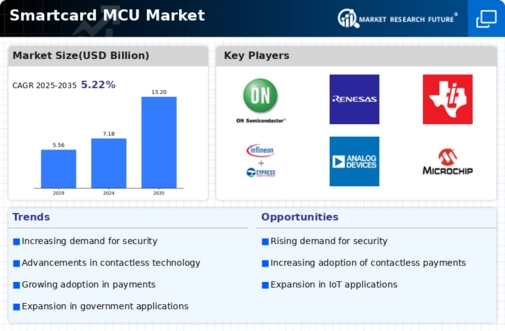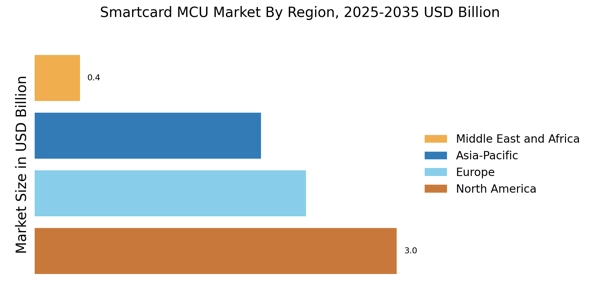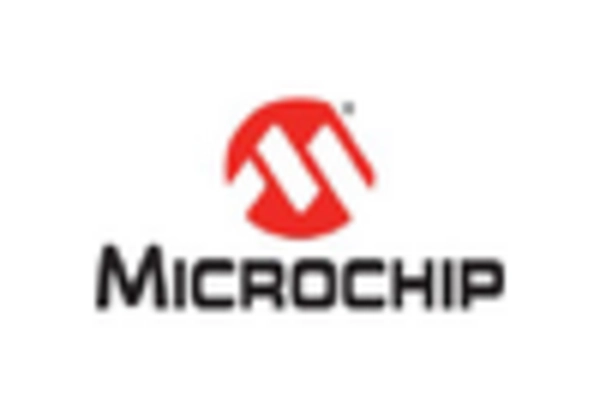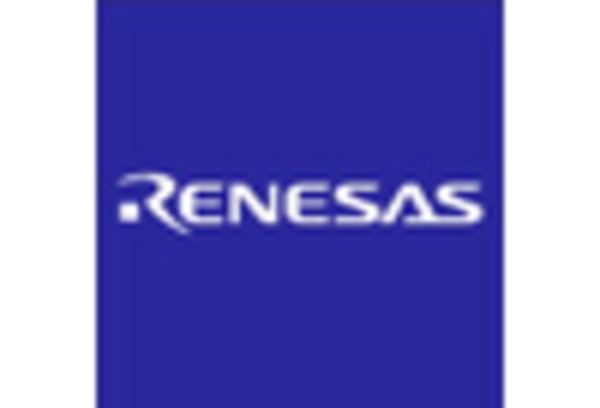Regulatory Compliance and Standards
Regulatory compliance plays a pivotal role in shaping the Smartcard MCU Market. Governments and regulatory bodies worldwide are increasingly mandating stringent security standards for payment systems and personal identification. For instance, the Payment Card Industry Data Security Standard (PCI DSS) has set forth requirements that necessitate the use of secure smartcard technology. As organizations strive to comply with these regulations, the demand for smartcard microcontrollers that meet these standards is likely to rise. This compliance not only ensures the protection of sensitive data but also fosters consumer confidence in digital transactions. The ongoing evolution of regulations may further drive innovation within the Smartcard MCU Market, as manufacturers seek to develop solutions that not only comply with current standards but also anticipate future requirements.
Expansion of E-Government Initiatives
The expansion of e-government initiatives is contributing to the growth of the Smartcard MCU Market. Governments are increasingly adopting digital solutions to streamline services and improve citizen engagement. Smartcards are being utilized for various applications, including digital identification, access control, and secure communication. As governments invest in technology to enhance service delivery, the demand for smartcard microcontrollers is expected to rise. In 2025, the e-government market is projected to reach a valuation of over 20 billion USD, indicating a robust opportunity for the Smartcard MCU Market. This trend not only reflects the shift towards digital governance but also highlights the critical role of smartcard technology in facilitating secure and efficient public services.
Increasing Adoption of Digital Payment Systems
The Smartcard MCU Market is experiencing a notable surge due to the increasing adoption of digital payment systems. As consumers and businesses alike gravitate towards cashless transactions, the demand for secure and efficient payment solutions has escalated. In 2025, it is estimated that the digital payment market will reach a valuation of over 10 trillion USD, driving the need for advanced smartcard microcontroller units. These units are integral in ensuring secure transactions, thereby enhancing consumer trust. The proliferation of mobile wallets and contactless payment methods further underscores this trend, as they rely heavily on smartcard technology. Consequently, manufacturers are compelled to innovate and enhance their offerings to meet the evolving needs of the market, positioning the Smartcard MCU Market for sustained growth.
Rising Demand for Identity Verification Solutions
The Smartcard MCU Market is also being propelled by the rising demand for identity verification solutions. As security concerns escalate across various sectors, including banking, healthcare, and government, the need for reliable identification methods has become paramount. Smartcards equipped with microcontrollers offer a secure means of verifying identity, thus gaining traction in applications such as e-passports and national ID cards. The market for identity verification solutions is expected to grow significantly, with estimates suggesting a value exceeding 15 billion USD by 2026. This trend is likely to drive investments in smartcard technology, as organizations seek to enhance their security protocols. Consequently, the Smartcard MCU Market is positioned to benefit from this growing emphasis on secure identity verification.
Technological Advancements in Smartcard Technology
Technological advancements are significantly influencing the Smartcard MCU Market. Innovations in microcontroller technology, such as enhanced processing power and improved security features, are enabling the development of more sophisticated smartcards. In 2025, the market is projected to witness a compound annual growth rate (CAGR) of approximately 8%, driven by these advancements. The integration of biometric authentication and encryption technologies into smartcards is becoming increasingly prevalent, providing an additional layer of security. Furthermore, the rise of Internet of Things (IoT) applications is creating new opportunities for smartcard integration, as these devices require secure communication channels. As technology continues to evolve, the Smartcard MCU Market is likely to adapt, fostering a competitive landscape that prioritizes innovation and security.

















Leave a Comment